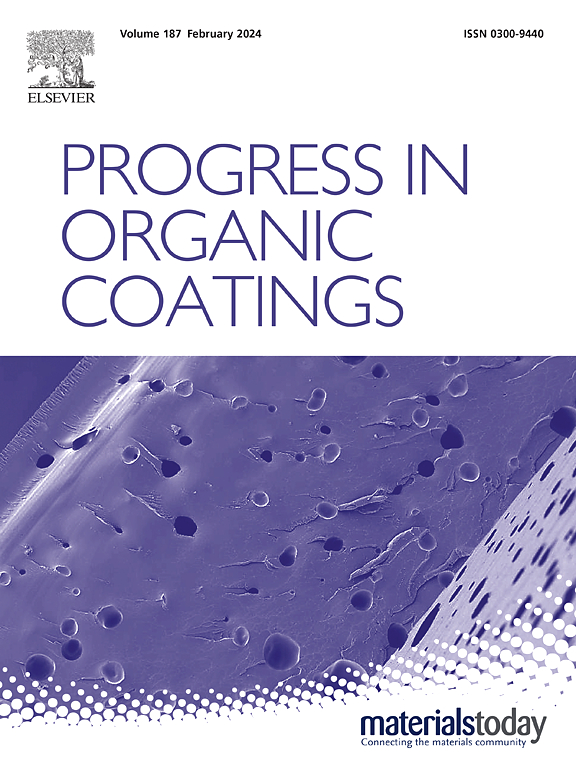聚己二酸丁二酯/聚对苯二甲酸乙酯纳米复合涂层纸基可持续包装屏障材料
IF 7.3
2区 材料科学
Q1 CHEMISTRY, APPLIED
引用次数: 0
摘要
对石油基包装的环境问题促使人们寻找可持续的纸基替代品,但纸的阻隔性和机械性能差限制了它在食品包装中的使用。本文介绍了一种新的、环保的策略,通过聚己二酸丁二酯-共对苯二甲酸乙酯(PBAT)和合成硅土纳米复合涂层来增强纸质包装。首次使用四氢呋喃(THF),一种毒性较小的非氯化溶剂,将PBAT溶解,纳米粘土分散,从而实现更安全、可扩展的涂层。通过核磁共振溶剂弛豫、形貌和分散性分析,选择了四种海长石级粘土(sumton -SEN, SEN)和sumton -STN (STN, STN)。将不同纳米粘土含量(3-7 wt%)和涂层克重的多层涂料应用于牛皮纸上,并对所得材料的机械性能、耐水耐油性能和气体阻隔性能进行了系统表征。PBAT- stn和PBAT- sen纳米复合纸的性能都优于纯PBAT涂层,其中PBAT- stn具有卓越的性能,在5 wt%的粘土负载下效果最佳。PBAT基质中分散良好的碳杂石纳米粘土通过增加扩散路径的弯曲度,显著提高了屏障性能,导致氧气和水蒸气的透过率大幅降低(与纯PBAT涂布纸相比,分别高达58.3%和48.5%)。优化后的pbat -粘土纳米复合涂层还具有优异的耐水性(最低Cobb 60值为0.3 g.m - 2),高耐油性(Kit number . 12),即使在高温下也能长时间不渗透油。这些结果表明PBAT/hectorite纳米复合涂层纸具有生物降解性、机械坚固性和卓越的保护功能,是一种有前途的、可持续的高级食品包装解决方案。本文章由计算机程序翻译,如有差异,请以英文原文为准。

Poly(butylene adipate-co-terephthalate)/synthetic hectorite clay nanocomposite coated paper-based sustainable barrier materials for packaging application
Environmental concerns over petroleum-based packaging have driven the search for sustainable paper-based alternatives, but poor barrier and mechanical properties of paper limit its use in food packaging. This work introduces a novel, eco-friendly strategy to enhance paper-based packaging by poly (butylene adipate-co-terephthalate) (PBAT) and synthetic hectorite clay nanocomposite coating. Utilizing tetrahydrofuran (THF), a less toxic, non-chlorinated solvent for the first time, PBAT was dissolved and nanoclay dispersed, enabling safer and scalable coatings. Four hectorite clay grades were evaluated for compatibility and dispersibility in THF, with Sumecton-SEN (SEN) and Sumecton-STN (STN) selected based on NMR solvent relaxation, morphology, and dispersion analyses. Multilayer coatings with varying nanoclay content (3–7 wt%) and coating-grammage were applied to kraft paper, and the resulting materials were systematically characterized for mechanical properties, water and oil resistance, and gas barrier properties. Both PBAT-STN and PBAT-SEN nanocomposite papers outperformed neat PBAT coatings, with PBAT-STN delivering superior performance, with optimal results at 5 wt% clay loading. The well-dispersed hectorite nanoclay in the PBAT matrix significantly improved barrier performance by increasing the tortuosity of diffusion pathways, leading to substantial reductions in oxygen and water vapor transmission rates (up to 58.3 % and 48.5 %, respectively compared to neat PBAT coated paper). The optimized PBAT-clay nanocomposite-coatings also demonstrated excellent water resistance (lowest Cobb 60 value 0.3 g.m−2), high grease resistance (Kit number-12), and no oil penetration for extended periods, even at elevated temperatures. These results establish PBAT/hectorite nanocomposite-coated paper as a promising, sustainable solution for advanced food packaging, combining biodegradability, mechanical robustness, and superior protective functionality.
求助全文
通过发布文献求助,成功后即可免费获取论文全文。
去求助
来源期刊

Progress in Organic Coatings
工程技术-材料科学:膜
CiteScore
11.40
自引率
15.20%
发文量
577
审稿时长
48 days
期刊介绍:
The aim of this international journal is to analyse and publicise the progress and current state of knowledge in the field of organic coatings and related materials. The Editors and the Editorial Board members will solicit both review and research papers from academic and industrial scientists who are actively engaged in research and development or, in the case of review papers, have extensive experience in the subject to be reviewed. Unsolicited manuscripts will be accepted if they meet the journal''s requirements. The journal publishes papers dealing with such subjects as:
• Chemical, physical and technological properties of organic coatings and related materials
• Problems and methods of preparation, manufacture and application of these materials
• Performance, testing and analysis.
 求助内容:
求助内容: 应助结果提醒方式:
应助结果提醒方式:


